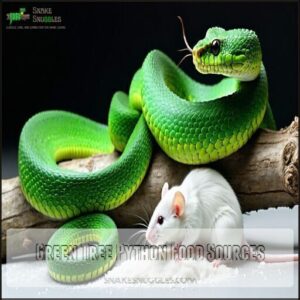This site is supported by our readers. We may earn a commission, at no cost to you, if you purchase through links.
 You’ll find that green tree pythons primarily feast on small mammals like rodents, birds, and lizards in their natural rainforest habitats.
You’ll find that green tree pythons primarily feast on small mammals like rodents, birds, and lizards in their natural rainforest habitats.
As juveniles, they’ll target smaller prey like frogs and lizards before graduating to meatier meals as adults.
In captivity, you can feed them appropriately-sized mice and rats, with occasional chicks for variety.
These emerald hunters are ambush predators, using their heat-sensing pits to detect warm-blooded prey while hanging motionless from branches.
Like nature’s perfect coil springs, they strike with lightning speed when dinner wanders too close.
Their feeding behavior changes dramatically as they mature, affecting both diet and hunting strategy.
Table Of Contents
- Key Takeaways
- Green Tree Python Diet Basics
- Green Tree Python Hunting Techniques
- Green Tree Python Prey Preferences
- Green Tree Python Feeding Schedule
- Green Tree Python Feeding Tips
- Green Tree Python Diet and Growth
- Green Tree Python Food Sources
- Green Tree Python Feeding Challenges
- Green Tree Python Diet and Health
- Green Tree Python Diet and Nutrition
- Frequently Asked Questions (FAQs)
- What do you feed a green tree python?
- Can you keep a green tree python as a pet?
- Is the green tree python aggressive?
- Do green tree pythons eat fish?
- What do pythons eat?
- How often do green tree pythons eat mice?
- Are green tree pythons picky eaters?
- How do green tree pythons find prey?
- Are green tree pythons predators?
- How Do Green Tree Pythons Hunt?
- Conclusion
Key Takeaways
- Green tree pythons eat small mammals, birds, and reptiles, with their diet changing as they grow from juveniles (eating lizards and frogs) to adults (preferring mice, rats, and birds).
- In captivity, they thrive on frozen-thawed rodents like mice or rats, and occasionally chicks, all matched to their size.
- They use heat-sensing pits to hunt nocturnally, ambushing prey with precision from branches and sometimes wiggling their tails to lure animals closer.
- Feed them every 5-7 days as juveniles and every 10-14 days as adults, ensuring proper nutrition and avoiding live prey to prevent injury.
Green Tree Python Diet Basics
You’ll find that green tree pythons maintain a strictly carnivorous diet consisting primarily of small mammals, birds, and reptiles that varies based on their age and size.
As your python grows from hatchling to adult, its prey preferences will naturally shift from small lizards and tree frogs to larger meals like mice, rats, and occasionally bats.
What Do Green Tree Pythons Eat in The Wild?
In their natural rainforest habitats, green tree pythons consume a diverse diet that varies by age and location.
Their wild diet typically includes:
- Small mammals such as Rattus leucopus and Melomys capensis, providing essential protein
- Arboreal reptiles including geckos and skinks caught among branches
- Birds seized during nocturnal hunting expeditions
- Amphibians like frogs and toads, particularly targeted by juveniles before shifting to larger prey
These emerald hunters have evolved specific prey preferences across their Australian and PNG distribution range.
What Do Green Tree Pythons Eat in Captivity?
While wild green tree pythons hunt a variety of prey, their captive diet is more structured yet still diverse.
Your pet python will thrive on a steady diet of frozen-thawed rodents as the primary food source.
Mice and rats from reputable suppliers like Layne Labs or RodentPro form the backbone of a proper green tree python diet.
Consider prey nutritional information for ideal health.
Choose prey size appropriate to your snake’s girth—the meal should create a noticeable bulge without overfeeding.
Always use feeding tongs to present prey, reducing risk of accidental bites.
Occasionally dust prey with reptile supplements like Arcadia RevitaliseD3 to prevent deficiencies.
Proper thawing methods are vital—warm the rodent thoroughly before offering it to your emerald hunter.
What to Feed a Baby Green Tree Python
After mastering captive diets for adult green tree pythons, you’ll need specialized knowledge for their babies. Hatchlings require particular care to guarantee proper development.
When feeding a baby green tree python, match their prey to their diminutive size. Proper nutrition during these early months establishes healthy growth patterns.
Follow this feeding protocol for ideal development:
- Start with pinky mice (newborn, hairless) every 5-7 days – their small size prevents regurgitation
- Ensure proper supplementation with occasional vitamin dusting of prey items
- Monitor for signs of hunger, including increased activity and tongue flicking
- Be vigilant about hatchling cannibalism if housing multiple babies together
Your hatchling’s first prey type should be appropriate to its jaw size. Most babies readily accept properly sized pinky mice, though some may initially prefer scented prey items that mimic their natural diet of small lizards.
Green Tree Python Hunting Techniques
You’ll be amazed at how green tree pythons combine patient ambush tactics with specialized heat-sensing pits to detect prey in complete darkness.
These emerald hunters strike with remarkable precision from their treetop perches, using their sensory adaptations to locate warm-bodied mammals and reptiles.
Before constricting them with deadly efficiency, they utilize their unique abilities to pinpoint their targets, making them highly effective predators in their environment.
How Do Green Tree Pythons Locate Prey?
Moving from basic diet information, let’s examine how green tree pythons manage to find their meals with such precision.
Green tree pythons employ remarkable sensory adaptations to locate prey in their arboreal environment. These skilled hunters rely on a combination of heat-sensing pits, acute eyesight, and clever ambush techniques.
When hunting, they position themselves on branches with their distinctive s-shaped coil, remaining motionless for hours. What’s fascinating is their specialized tail lure behavior—they wiggle their tail tip to mimic a worm, attracting curious prey within striking distance.
Their thermal vision allows for effective nocturnal hunting, detecting warm-bodied animals even in complete darkness. This sophisticated prey detection system makes green tree pythons exceptionally efficient ambush predators, striking with lightning speed and accuracy when an unsuspecting meal ventures too close.
How Do Green Tree Pythons Use Their Heat-Sensing Pits?
Green tree pythons possess remarkable heat-sensing pits that revolutionize their hunting capabilities. Located along their lower jaw, these specialized organs detect infrared radiation emitted by warm-blooded prey with astonishing thermal acuity.
In complete darkness, these nocturnal hunters rely on their pit organs to create a thermal image of their surroundings. When a mouse or bird passes below, the python’s sensory integration system processes these heat signatures, allowing for pinpoint strikes from their treetop perches.
- Unlike human vision, these pits can detect temperature differences as small as 0.003°C, making prey detection nearly foolproof even when visual cues are absent.
This remarkable adaptation makes green tree pythons formidable ambush predators in their dense forest habitats, utilizing their unique thermal image capabilities to thrive.
Green Tree Python Prey Preferences
You’ll find green tree pythons have remarkably selective dining habits, favoring small mammals like mice, rats, and bats, while also consuming various reptiles including geckos and skinks.
Their prey preferences shift as they mature, with juveniles targeting mainly small lizards and tree frogs before graduating to larger mammals that provide the substantial nutrition these emerald hunters require.
What Small Mammals Do Green Tree Pythons Eat?
The diet of green tree pythons centers on four principal small mammals that provide essential nutrients for these emerald hunters.
In their natural habitat, these pythons primarily consume:
- Mice (Rattus leucopus) – Their staple food in both wild and captive settings
- Rats (Melomys capensis) – Offering substantial protein for growth and maintenance
- Bats – Occasionally captured during nighttime hunting sessions
- Small marsupials – Regional delicacies in their Australian habitats
When selecting rodent options for your captive python, remember that rodent size matters considerably.
You’ll need to match prey dimensions to your snake’s girth, ensuring proper nutritional rodent value without risking regurgitation.
What Reptiles Do Green Tree Pythons Eat?
While we’ve seen how green tree pythons feast on mammals, they’re equally fond of reptilian meals.
These emerald hunters exhibit impressive lizard consumption patterns in their natural habitats.
Green tree pythons primarily target five main reptile types:
- Geckos (especially arboreal species)
- Skinks (including Carlia longipes)
- Various lizard species
- Small reptiles they encounter while hunting
Their preference for gecko predation is particularly notable. With specialized heat-sensing pits, they detect these quick-moving prey even in darkness. The skink diet provides essential nutrients that complement their nutritional needs.
When hunting, green tree pythons position themselves strategically on branches, waiting for juvenile reptiles to wander within striking distance. Their curved teeth are perfectly adapted for gripping slippery lizards.
Interestingly, the python’s consumption of arboreal reptiles often depends on availability rather than preference—they’re opportunistic predators that won’t pass up an easy meal.
Do Green Tree Pythons Eat Amphibians?
Contrary to popular belief, green tree pythons rarely eat amphibians in the wild.
Research conducted on over 1,000 specimens showed no evidence of frog consumption in their natural diet.
These emerald hunters focus primarily on:
- Small mammals like mice and rats
- Reptiles such as geckos and skinks
- Occasionally birds, though less frequently than mammals
While many snakes might consume frogs when other food sources are scarce, green tree pythons have evolved as specialists in mammal and reptile predation.
In captivity, you’ll want to respect this natural preference by offering appropriate rodent prey to ensure their well-being and natural diet.
Green Tree Python Feeding Schedule
You’ll need to adjust your feeding schedule based on your green tree python’s age, with hatchlings requiring meals every 5 days while adults can go 10-14 days between feedings.
Understanding this feeding timeline helps prevent both overfeeding and underfeeding, ensuring your emerald arboreal hunter maintains peak health throughout its 20-year lifespan.
How Often to Feed a Baby Green Tree Python
Now that we’ve examined what green tree pythons prefer to eat, let’s consider how often these emerald beauties need feeding during their earliest stage of life.
Hatchling feeding frequency typically follows a 5-7 day schedule. Your baby green tree python requires these regular meals to support their rapid growth rate.
Offer appropriately-sized pinky mice, being careful not to overwhelm their digestive system, which could lead to regurgitation risk. Your feeding schedule may need slight adjustments based on individual needs—some hatchlings thrive with more frequent meals while others need slightly less, depending on their unique requirements for optimal health.
How Often to Feed a Juvenile Green Tree Python
Now that your baby green tree python has matured into a juvenile, you’ll need to adjust their feeding schedule. As these emerald hunters continue developing, their nutritional needs evolve alongside their growth stages.
For ideal health during this critical period, follow these guidelines:
- Feed juveniles one appropriately-sized prey item (typically a hopper or small adult mouse) every 7-10 days
- Extend the interval to 10-14 days during or immediately after shedding
- Monitor activity levels—increased movement often signals hunger
Remember that feeding frequency should decrease slightly from the hatchling stage, while prey size increases proportionally. Your juvenile’s body condition—slightly filled out but not obese—offers the best indicator of proper nutrition.
How Often to Feed an Adult Green Tree Python
While juveniles need more frequent meals, adult green tree pythons require feeding less often as their metabolic rate slows.
Your emerald hunter now thrives on a consistent schedule suited to its needs.
| Age | Prey Size | Frequency |
|---|---|---|
| Adult | Small rat | Every 10-14 days |
| During shedding | Medium mouse | Delay until complete |
| Seasonal variation | Appropriate size | Every 14-21 days (winter) |
Monitor your python’s activity level and body condition to adjust feeding frequency accordingly.
Green Tree Python Feeding Tips
You’ll need to master specific feeding techniques to keep your green tree python healthy, including using feeding tongs to present properly sized, thawed rodents while avoiding accidental bites during the process.
Providing appropriate prey items along with occasional vitamin supplements will guarantee your emerald hunter maintains prime nutrition, similar to what they’d consume in their natural habitat, ensuring they remain a healthy emerald hunter.
What to Feed a Green Tree Python
After establishing your feeding schedule, selecting the right food for your green tree python becomes your next priority.
Your python’s diet should center on appropriately sized prey that matches their developmental stage. Prey size matters substantially – offering items too large can cause stress and regurgitation.
For proper nutrition, focus on these python food staples:
- Frozen-thawed rodents (mice or rats) that are 1-1.5 times the diameter of your snake’s mid-body section
- Occasional chicks or quail (for adult pythons) to provide captive prey variety and mimic natural feeding patterns
- Small lizards or geckos (captive-bred only) as occasional treats for adults that seem reluctant to eat
Supplement dusting prey items with calcium powder once monthly helps prevent nutritional deficiencies. When thawing frozen rodents, use warm water rather than microwaves, which can create dangerous hot spots.
Sourcing quality prey from reputable suppliers guarantees your arboreal snake diet remains free of parasites and harmful chemicals that could impact your emerald hunter’s long-term health.
How to Feed a Green Tree Python
Properly feeding your green tree python requires attention to detail and safety precautions. Always use feeding tongs to present prey, keeping a safe distance between your fingers and those lightning-quick strikes.
Thaw frozen rodents completely and warm them to approximately 98°F before offering to mimic live prey’s body temperature. Using the right tools is essential, so consider investing in specialized reptile equipment.
Adjust prey size as your python grows—a good rule is feeding items no larger than the widest part of your snake’s body. Monitor your python’s feeding response and body condition, modifying the feeding frequency accordingly.
For safe handling during python care, choose a quiet environment away from distractions to reduce stress and maximize successful feeding sessions.
What Not to Feed a Green Tree Python
Responsible owners should know what to avoid in their green tree python’s diet. Improper feeding can lead to serious health consequences.
Here are 5 items to never feed your green tree python:
- Live rodents – They can injure your snake and cause unnecessary stress
- Single-prey diets – Relying solely on rats or mice doesn’t provide balanced nutrition
- Prey on loose substrates – Use coarse bark woodchips to prevent accidental ingestion
- Excessive food – Adult pythons should eat only once every two weeks to prevent obesity
- Improperly thawed prey – Always warm food to approximately 100°F/38°C before offering
To prevent regurgitation, avoid handling them for 48 hours after feeding.
Remember, a green tree python’s diet requires careful attention to guarantee their health and longevity.
Green Tree Python Diet and Growth
You’ll see dramatic transformations in your green tree python as its diet evolves from small lizards and amphibians as a juvenile to larger mammals like mice and rats as an adult.
The quality and consistency of your python’s diet directly influences its growth rate, color development, and overall health throughout its 15-20 year lifespan.
How Diet Affects Green Tree Python Growth
Your green tree python’s growth rate is directly linked to its diet. Proper nutrition affects not just size, but also coloration impact and overall development.
Young pythons need more frequent feedings with appropriately sized prey to support their rapid growth phase. The python diet should evolve as your snake matures—smaller, more frequent meals for juveniles shifting to larger, less frequent feedings for adults.
Inconsistent feeding patterns often result in stunted growth or health complications. A juvenile green tree python requires balanced nutrition with proper supplements to achieve its full potential and vibrant emerald coloration.
How to Promote Healthy Growth in Green Tree Pythons
To promote healthy growth in your green tree python, create an environment that supports their natural development from the inside out.
Consistent feeding and proper habitat management work together for ideal results.
- Provide ideal UVB lighting with a 5.0 or 6% bulb placed 10-15 inches from basking spots
- Maintain proper enclosure size (minimum 36"L x 24"W x 24"H) with multiple climbing branches
- Implement a varied diet of appropriately-sized rodents, occasional birds, and reptiles
- Follow a supplement schedule with calcium and vitamins dusted on prey items every 3-4 feedings
- Use appropriate hydration methods including regular misting and a clean water bowl
Monitor your snake’s weight, shed quality, and activity levels as indicators of health.
Adjust their python diet seasonally, as these emerald hunters naturally experience different feeding patterns throughout the year.
Your green tree python’s healthy growth depends on this thorough approach to reptile diet management.
They’ll thrive when you combine proper nutrition with environmental factors that mirror their natural habitat.
Green Tree Python Food Sources
You’ll find that green tree pythons thrive on a diet of appropriately sized rodents from reputable suppliers like Layne Labs, RodentPro, and Reptilinks, which provide the essential nutrients these emerald hunters need.
While captive pythons primarily consume frozen-thawed mice and rats that you’ve properly warmed, occasionally dusting prey with supplements such as Arcadia RevitaliseD3 can prevent nutritional deficiencies and support peak health.
Live Prey Vs. Frozen-Thawed Prey
When selecting food for your green tree python, you’ll face an important choice between live and frozen-thawed prey.
Live prey stimulates natural hunting behaviors but carries significant risks—defensive rodents can injure your snake with bites or scratches.
Frozen-thawed prey eliminates these live prey risks while maintaining proper python prey nutrition.
Ethical considerations also favor pre-killed options, reducing suffering for feeder animals.
For ideal snake prey digestion, thaw items to approximately 100°F before offering.
Gut loading live feeders can improve nutritional content, but frozen options preserve most nutrients when properly stored.
Though some pythons initially resist frozen-thawed prey, consistent presentation typically leads to acceptance within your green tree python diet regimen.
Frozen rodents also offer convenient long-term storage with significant benefits for snake owners, making them a practical choice.
Where to Buy Food for Green Tree Pythons
Reputable vendors guarantee your emerald hunter receives superior nutrition. When sourcing food for your green tree python, you’ll find multiple options with varying advantages.
Pet stores and local reptishops provide immediate access to frozen mice and rats, though their selection might be limited. Online retailers like RodentPro and Reptilinks offer convenient home delivery with impressive variety and often better pricing comparison options. You can also find reptile food from a variety of online vendors.
Reptile expos present opportunities to purchase bulk food items at competitive prices while connecting with specialized breeders. Many online breeders maintain high food quality standards, with some focusing exclusively on nutritionally complete feeder animals.
When evaluating sources, consider:
- Consistency of frozen mouse food availability
- Shipping methods that maintain proper temperature
- Reviews from other reptile keepers
- Price-to-quality ratio across different vendors
Your python’s health directly reflects its diet’s quality!
Green Tree Python Feeding Challenges
You’ll face several obstacles when feeding your green tree python, from their notorious feeding strikes to their sometimes puzzling refusal to eat during seasonal changes or stress.
Proper technique using feeding tongs, correct prey temperature, and understanding your python’s environmental preferences can transform these emerald beauties from finicky eaters into consistent feeders.
Why Won’t My Green Tree Python Eat?
Despite your best efforts, you may notice your green tree python refusing meals at times. Understanding why this happens is vital for maintaining proper nutrition and health.
Several factors can trigger feeding refusals in these emerald hunters:
- Stress Reduction needs – excessive handling or enclosure disruptions can suppress appetite
- Temperature Gradient issues – improper heating can disrupt digestion and feeding behavior
- Shedding Cycle phases – many pythons naturally fast when preparing to shed
- Health Conditions requiring veterinary attention – respiratory infections or dehydration often cause appetite loss
Environmental stressors like improper Enclosure Setup or inconsistent husbandry substantially impact your python’s willingness to eat. When your snake skips a meal, don’t immediately panic – occasional feeding refusals are common.
However, if your python refuses food for multiple scheduled feedings, a Veterinary Checkup becomes essential to rule out serious health problems.
How to Encourage a Green Tree Python to Eat
When your green tree python refuses meals, don’t panic. After examining why they mightn’t be eating, it’s time for action.
Try these proven techniques to stimulate appetite:
| Technique | Benefit | When to Use |
|---|---|---|
| Dawn/dusk feeding | Aligns with natural hunting times | Always |
| Prey movement | Triggers predatory response | Reluctant eaters |
| Temperature gradient | Optimizes digestion | Seasonal changes |
| Privacy during feeding | Reduces stress | New environments |
| Prey scenting | Enhances food detection | Extreme cases |
Proper enclosure enrichment with climbing branches gives your snake confidence. Maintain 70-80% humidity and offer variety in prey size. Sometimes gentle wiggling of prey with feeding tongs can trigger their hunting instinct. Remember, patience is key—rushing will only increase feeding refusals.
Common Feeding Mistakes to Avoid
Now you’ve learned how to encourage your snake to eat, let’s look at mistakes that can harm your emerald hunter’s health.
Many keepers stumble into these feeding pitfalls:
- Overfeeding – Creates obesity risks and stress on internal organs
- Improper thawing – Feeding partially frozen prey can cause digestive issues
- Wrong size selection – Prey should be 1-1.5 times the diameter of your python’s midsection
- Handling post-feeding – Disturbing your snake after meals may trigger regurgitation
Supplement neglect is another common error. While green tree pythons don’t require supplements with every meal, occasional dusting prevents deficiencies.
Remember, nutritional balance isn’t just about what you feed—it’s about developing a consistent, appropriate feeding schedule.
Green Tree Python Diet and Health
You’ll find that your green tree python’s diet directly impacts its overall health, with proper nutrition preventing common issues like scale rot, respiratory infections, and digestive problems.
Providing a varied diet of appropriately-sized rodents, supplemented occasionally with reptile vitamins, guarantees your emerald hunter maintains its vibrant coloration and reaches its potential 20-year lifespan.
How Diet Affects Green Tree Python Health
Your green tree python’s diet plays a vital role in six major health aspects.
A properly balanced diet supports immune function, promotes proper growth, and guarantees vibrant coloration that makes these emerald hunters so striking.
When you provide nutritional variety, you’re not just feeding your python—you’re building its defense against disease and supporting its natural beauty.
Snake nutrition isn’t just about fullness; it’s about balance.
| Health Aspect | Proper Diet Impact | Poor Diet Impact |
|---|---|---|
| Organ Function | Efficient metabolism | Fatty liver disease |
| Lifespan Correlation | Extended longevity | Shortened lifespan |
| Obesity Risks | Healthy weight | Respiratory strain |
| Supplement Needs | Minimal if varied diet | Deficiencies common |
| Coloration Impact | Brilliant emerald hues | Dull, uneven coloring |
Providing a properly balanced diet supports overall health, and a varied diet is key to minimizing supplement needs and ensuring your python’s vibrant coloration.
By focusing on these aspects, you can help extend your python’s lifespan and support its overall well-being.
Common Health Issues in Green Tree Pythons
While proper nutrition supports your green tree python’s health, several diet-related issues can still arise.
Parasites often enter through contaminated prey, while improper feeding techniques may cause regurgitation and digestive stress. Respiratory infections develop when humidity levels fluctuate, and conditions like scale rot and mouth rot (stomatitis) emerge from poor enclosure maintenance.
Watch for incomplete shedding—it’s typically a red flag for dehydration or nutritional deficiencies. A common issue to watch out for is signs of dehydration, such as wrinkled skin.
Your python’s vibrant color and regular activity signal good health, but dull scales or unusual lethargy demand immediate veterinary attention.
Remember, prevention through proper diet and habitat management is your best defense.
Green Tree Python Diet and Nutrition
You’ll need to provide your green tree python with whole animal prey for ideal nutrition, as their carnivorous diet requires specific nutrients only found in complete prey items.
Though captive pythons can survive on a steady diet of appropriately sized rodents, occasional supplementation helps prevent potential deficiencies that could affect their vibrant coloration and overall health.
Nutritional Requirements for Green Tree Pythons
Building on what we’ve learned about health concerns, your green tree python’s nutritional requirements demand careful attention to maintain peak wellbeing in captivity.
Green tree python diet revolves around whole prey items that provide complete nutrition. Unlike mammals, reptiles process nutrients differently, requiring specific attention to their unique needs:
- Balanced calcium-phosphorus ratio: Essential for preventing metabolic bone disease and supporting skeletal health
- Vitamin D3 access: Necessary for calcium absorption and metabolism
- Hydration importance: Offered through proper humidity and fresh water
- Gut health support: Maintained through varied prey types
You’ll find that a well-fed python displays vibrant coloration, steady growth, and appropriate shedding patterns. Supplement options should be used sparingly, as over-supplementation can be as harmful as deficiencies.
Common Nutritional Deficiencies in Green Tree Pythons
While green tree pythons can survive without supplements, nutritional deficiencies can still develop even with regular feeding.
Your scaly friend may experience calcium imbalance leading to metabolic bone disease if not properly supplemented.
UVB lighting helps prevent vitamin D3 deficiency while supporting immune health. Occasionally dusting prey with a reptile supplement before feeding maintains nutritional balance.
Without proper care, vitamin deficits can lead to more serious issues like organ failure. Regular vet check-ups can help catch deficiencies early.
A varied diet combining different prey items naturally addresses most nutritional needs, but supplementation offers insurance against hidden deficiencies. Hydration problems and obesity risks also increase when diet isn’t properly balanced.
Frequently Asked Questions (FAQs)
What do you feed a green tree python?
You’ll need to feed your green tree python appropriately sized rodents like mice and rats.
Juveniles start with smaller prey, while adults can handle larger items.
Offer food every 7-14 days depending on size.
Can you keep a green tree python as a pet?
Imagine a vibrant emerald serpent coiled gracefully around a branch in your home.
Yes, you can keep a green tree python as a pet, but they’re not for beginners due to their specialized care requirements.
Is the green tree python aggressive?
Green tree pythons aren’t typically aggressive, but they’re defensive when threatened. You’ll notice they’re more flighty than confrontational, though they can deliver painful bites with their 100 sharp teeth if provoked.
Do green tree pythons eat fish?
Finicky forest dwellers don’t favor fish in their diet.
You won’t find them hunting aquatic prey, as they’re strictly focused on consuming small mammals, birds, and reptiles in both wild and captive environments.
What do pythons eat?
Pythons devour a variety of prey including rodents, birds, reptiles, and mammals.
You’ll find they consume animals whole, constricting them first.
Their diet changes as they grow, with adults tackling larger meals than juveniles, which is a key aspect of their development, including the fact that they are consuming animals whole.
How often do green tree pythons eat mice?
Ever wondered about your scaly friend’s feeding schedule?
Adult green tree pythons typically eat mice every 10-14 days, while juveniles need meals more frequently—about every 5-7 days to support their growth.
Are green tree pythons picky eaters?
While not particularly picky, you’ll find these snakes have preferences.
They’ll typically accept appropriately sized rodents in captivity, but may refuse food during shedding periods or if environmental conditions aren’t quite right.
This behavior is also influenced by their natural instincts and environmental factors.
How do green tree pythons find prey?
Green tree pythons use heat-sensing pits to detect warm-blooded prey in darkness.
They’ll ambush from above, relying on their exceptional eyesight and stillness, often wiggling their tails like worms to lure curious victims within striking distance.
Are green tree pythons predators?
Silent stalkers with sharp senses, green tree pythons are natural-born predators.
They patiently wait, then strike swiftly, using heat-sensing pits and camouflage to ambush prey.
They rely on their muscular coils to constrict and capture their meal, showcasing their efficiency as natural-born predators.
How Do Green Tree Pythons Hunt?
They use their sharp vision, heat-sensing pits, and stillness to ambush prey from high perches.
Employing their tails as lures, they strike quickly, constrict victims for efficient hunting, and can consume meals several times their size, utilizing efficient methods.
Conclusion
Did you know green tree pythons can consume prey nearly 50% of their body size?
These ambush predators rely on their heat-sensing pits to hunt small mammals, birds, and reptiles in the wild.
In captivity, their diet shifts to frozen-thawed mice, rats, or chicks—appropriately sized for their age.
Feeding schedules change as they mature, with babies eating more often than adults, and by understanding what green tree pythons eat, you can guarantee their health and natural behavior thrive.
- https://academic.oup.com/biolinnean/article/107/2/269/2701496
- https://www.journalofherpetology.org/doi/abs/10.1670/12-207
- https://www.academia.edu/9633630/Foraging_ecology_and_diet_of_an_ambush_predator_the_green_python_Morelia_viridis_
- https://animaldiversity.org/accounts/Morelia_viridis/
- https://www.itis.gov/servlet/SingleRpt/SingleRpt?search_topic=TSN&search_value=634781



















